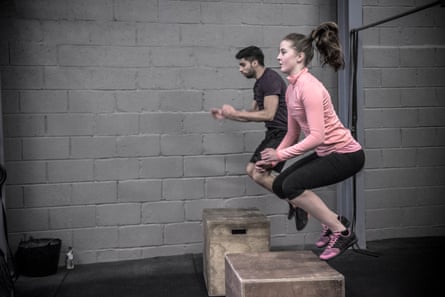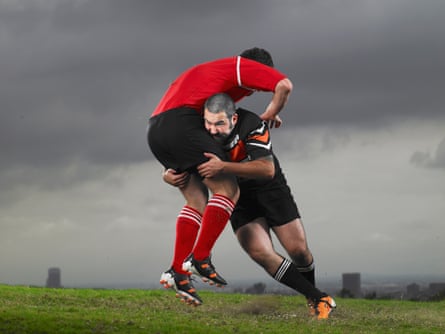Minimize the risk of injury while participating in activities such as running, skiing, swimming, cycling, football, rugby, and yoga.
P
Prevention is more effective than treatment, especially in regards to exercise. When starting a new sport or workout routine, it can be tempting to push yourself too hard due to the rush of endorphins or competitive spirit. However, this can result in ligament or muscle injuries that may last for months or even years. To help you avoid common injuries related to your chosen type of training, we have gathered a team of experienced coaches and athletes to guide you. And if you find all of this overwhelming, remember that the simplest way to prevent future health problems is by getting active and leaving the couch. Let’s get started…
Running

The most basic type of physical activity can be easily overdone. According to Tom Berry, a personal trainer and sprint coach at the University of Exeter, the three most common problems experienced by runners are achilles soreness, iliotibial band pain, and shin splints. These issues are often a result of pushing oneself too hard too quickly. The achilles tendon, which is the longest and strongest tendon in the body, plays a crucial role in controlling the impact of your foot hitting the ground. The iliotibial band, also known as the ITB, is a long fibrous tissue that helps stabilize the knee laterally. Shin splints is a broad term used to describe various lower leg problems, but it is commonly used to refer to pain in the tibialis anterior muscle, located on the outside of the shin.
Effectively managing the amount of training you do, specifically the number of times your feet make contact with the ground, is crucial in preventing three common conditions. The good news is that our bodies can adapt to increased levels of running over time, reducing the risk of injury. It is important to allow for adequate recovery time, so it is recommended for runners to have 48 hours between running sessions. Working with a coach can also be beneficial, as they can address technique issues that may contribute to conditions such as lateral shin splints. Additionally, incorporating strength training into your routine can help build resilience in your body. Exercises targeting the glutes and abductors can assist in stabilizing the knee, rather than relying solely on the ITB. Simple exercises like calf raises can also be effective in strengthening the calf muscles and reducing the chance of achilles pain, commonly included in rehabilitation programs.
Football

Display the image in full screen.
You may not possess the agility of Lionel Messi on a five-a-side soccer field, but you are still susceptible to the same types of injuries as him. According to Rayen Monzer, a professional footballer in Poland, adductor tears are a common occurrence among players. This is due to the fact that these small yet crucial leg muscles are often neglected in strength training. Adductors, which pull inward, are often overworked and can become strained when compensating for weaker muscles. To prevent this, it is important to activate your glute muscles. Sitting for extended periods of time can cause them to become inactive, so incorporating exercises like “fire hydrants” (lifting one leg while on all fours and rotating) and squeezing your glutes during squats can help wake them up. While having proper cleats or insoles in your shoes can aid in comfort and control, it should not be solely relied upon for injury prevention.
Tennis

Pain in the elbow, known as tennis elbow, is caused by small tears and inflammation around the outer bone of the elbow. It is not limited to just tennis players, as any repetitive arm movements can lead to this condition. However, playing tennis without proper preparation can exacerbate the pain. Marc Massad, a professional coach for tennis and pickleball, suggests using a racket that fits your weight, balance, and grip size to prevent tennis elbow. Additionally, performing exercises that strengthen the muscles in the forearm can also be helpful. Tennis players are often at risk for shoulder injuries due to repeated overhead serves, so incorporating exercises that improve shoulder mobility and stability can aid in prevention. One exercise to try is external rotations using a resistance band attached to an anchor at waist height. Another potential concern is ankle sprains from sudden side-to-side movements. Wearing appropriate footwear can mitigate this risk, but practicing balance exercises can also be beneficial.
Swimming

Swimmers often face various health issues related to their sport, but one of the most bothersome is not a physical injury. “Swimmer’s ear” refers to an infection caused by water that becomes trapped in the ear canal. This can be prevented by using earplugs or rinsing the ears with clean water after swimming. Other common overuse injuries among swimmers include “swimmer’s shoulder” and “swimmer’s knee,” which can result from improper stroke technique. To prevent swimmer’s shoulder, it is important to improve stroke mechanics and strengthen the shoulder muscles through exercises such as pull-aparts, reverse flys, rows, front raises, lateral raises, and internal and external rotations. Swimmer’s knee is caused by repetitive strain on the joints at awkward angles and can be avoided by focusing on proper technique, varying strokes, and performing mobility and stability exercises. Lunges, including front, reverse, and lateral variations, are particularly helpful in preventing swimmer’s knee.
Weight training

Display image in full screen mode.
Strength training may initially seem risky, but it is actually less prone to injuries compared to other sports, as long as proper precautions are taken. According to strength coach Joseph Lightfoot, weightlifting is a relatively low-risk activity, especially when one is knowledgeable about their own body and its capabilities. The most common areas of concern are the lower back and shoulders, which can be addressed by incorporating core work and maintaining proper lifting form with the guidance of a coach. For shoulder health, maintaining a 2:1 ratio of pulling to pushing exercises is recommended. Additionally, a thorough warm-up routine, such as the Ramp framework, can help raise body temperature, activate muscles, mobilize joints, and prepare the body for the workout ahead.
By the way, if you’re curious about the most dangerous exercise, it is likely the bench press. According to a study from 2003 that looked at mortality rates, 22 of 25 reported deaths while lifting came from bench press or other exercises done while lying down, with many occurring in home gyms. It is recommended to have a spotter present if you are approaching muscle failure.
Skiing

Display the image in full-screen mode.
If you’re wearing a helmet (which you should be), the next concern is your legs. According to Dr. Matthew Perry, a physical therapist, the most frequent injuries in skiing involve the anterior cruciate ligament (ACL). This ligament is vital for stabilizing the knee joint and is often damaged from falls, ski crossing, or improper landings. ACL injuries can range from mild strains to full tears.
One way to prevent injuries while skiing is by doing prehab exercises several weeks or even months in advance. It is important to focus on strengthening the muscles in your hips and lower body through exercises like squats, lunges, and plyometrics. Additionally, investing in properly fitting ski boots and bindings can reduce the risk of injury. Shoulder dislocations are also common among skiers, often caused by poles getting stuck behind the body. These falls or collisions can result in fractures of the collar bone or upper arm. To improve resilience, using SkiErg machines or performing overhead presses with a barbell or dumbbells can help build strength and bone density in the shoulders. Taking ski lessons can also be beneficial in learning proper technique and how to safely fall.
Circuit training

Participating in activities like CrossFit, F45, and Hyrox can lead to varying levels of competitiveness. While this can be beneficial for burning more calories, it can also be harmful if it leads to pushing yourself too far. Jana Barrett, a fitness and movement coach who focuses on clients over 40, explains that many injuries occur because individuals let their ego drive them to lift heavier weights than they can handle while maintaining proper form. This is often motivated by the fear of being seen as lazy and the belief that “no pain, no gain” is the only way to succeed. To avoid injury, it is important to recognize your limitations and not overexert yourself.
The speaker goes on to explain that there are some common issues that she frequently encounters. One of these is tight and weak hip flexors, which can cause discomfort and make simple tasks like getting out of a car difficult. This problem is often caused by sitting for long periods of time and then putting strain on the hips with heavy deadlifts. A quick and effective solution for tight hips is a warm-up routine focused on mobility, incorporating movements like shin box switches, shin box extensions, leg swings, tabletops, and bridges.
Another issue that is relevant for runners is having underactive glutes. This can result in hip pain (as the hip flexors are overcompensating) as well as lower back pain. The speaker notes that men, in particular, tend to have dominant quad muscles and may not know how to properly engage their glutes. To address this, she recommends performing exercises that target the glutes and activate them before training sessions. This can include light hip thrusts, bridges, and tabletops.
Yoga

Display the image in full screen mode.
Yoga classes, often associated with relaxation, can actually be surprisingly physically demanding. Despite this, the most common injuries that occur during practice may not be what you expect. According to yoga instructor Iana Varshavska, knee injuries are among the most frequent. Certain poses may seem simple for some, but pose a risk for others. For example, the lotus pose requires rotation in the hip joints rather than the knees or ankles. Attempting this pose without the proper hip joint structure can lead to knee cartilage injury. Similarly, the hero pose may not be suitable for everyone, especially those with larger ankles who may benefit from using props for support. Overall, it is important to ensure that the knees and feet are aligned in order to avoid any harmful twisting in the joints. If necessary, using knee pads or a yoga blanket can help alleviate pressure on the joints.
Cycling

Display the image in full screen mode.
Cycling is a low-impact activity, but it can still lead to knee pain if not prepared properly. The most common issue for cyclists is patellofemoral pain syndrome, which causes discomfort in the front of the knee around the kneecap. Dr. Brent Wells, a chiropractor who frequently treats cyclists, suggests strengthening the quadriceps and hamstrings on non-cycling days with exercises such as squats, lunges, leg presses, hamstring curls, or step-ups to help prevent this issue. Improper saddle or pedal adjustments on the bicycle can also worsen the problem.
“Patellar tendinitis, also known as ‘jumpers’ knee’, can be caused by repetitive strain on the kneecap tendon while cycling. This can cause small tears in the tendon, resulting in inflammation and discomfort.” While strength training may provide some relief, it is important to gradually increase training volume to prevent further injury.
Rugby

The physical therapist, Perry, explains that rugby is known for its high rate of injuries due to the intense collisions involved in the game. However, even in the minimal-contact version, there is still a risk of injury. Shoulder injuries, such as dislocations and joint separations, are common in rugby as the shoulder is often the first point of contact with the ground during a tackle. To prevent these injuries, Perry recommends incorporating rotational exercises like the “around the world” dislocate with a stick or band into your warm-up routine to improve mobility. Another beneficial exercise is the “banded chop,” which can strengthen your shoulders’ ability to withstand impact.
For those playing touch rugby, hamstring strains are a primary concern due to the quick sprints and sudden stops required in the game. It is essential to warm up properly before playing, including movements like the single-leg deadlift (without weight) and Romanian deadlifts. And for those playing regular rugby, wearing a mouth guard is highly recommended for added protection.
Source: theguardian.com



